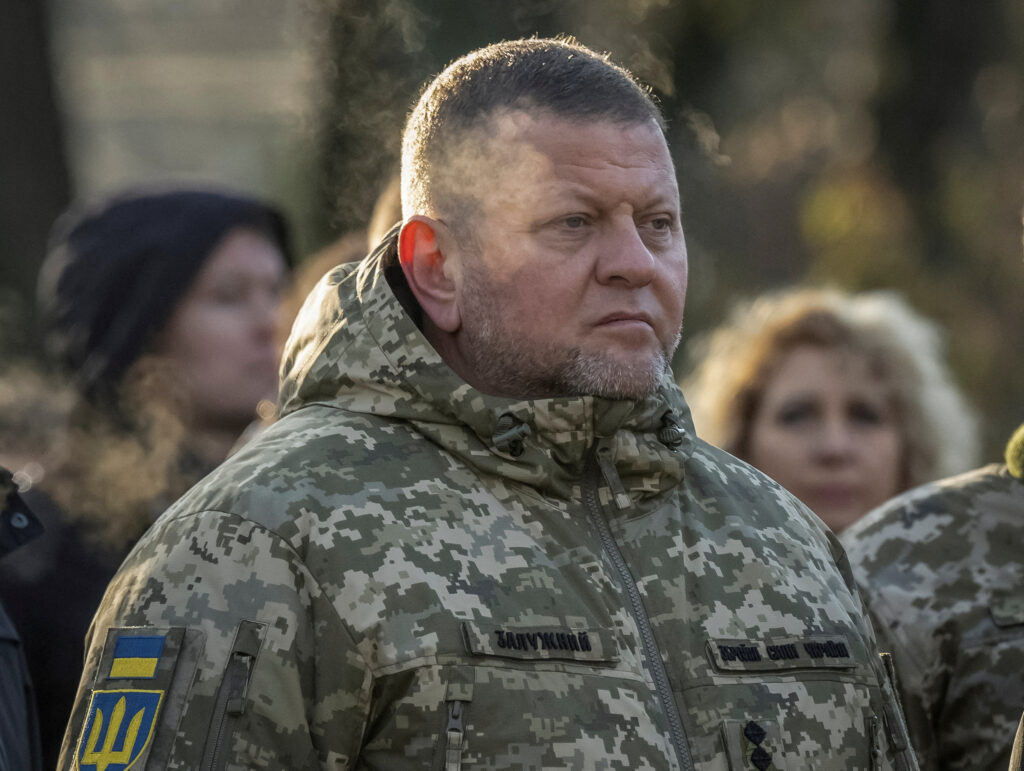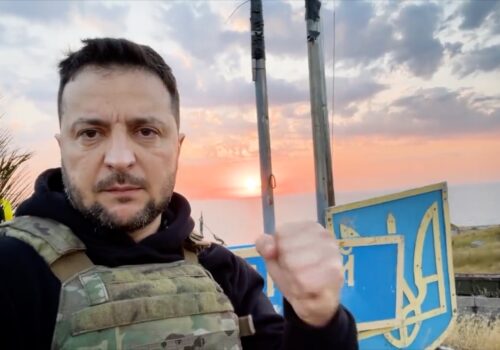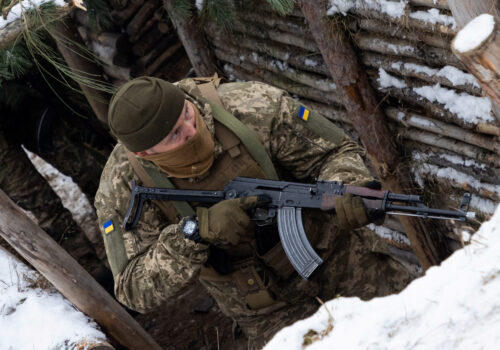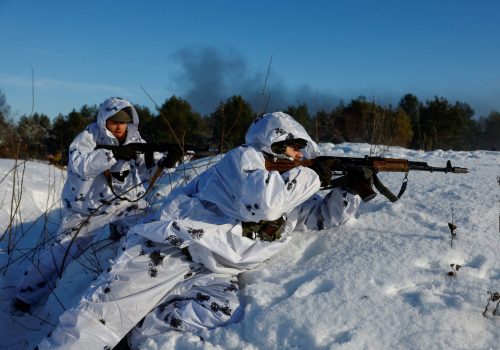
Removal of Ukraine’s ‘Iron General’ is one of Zelenskyy’s biggest gambles
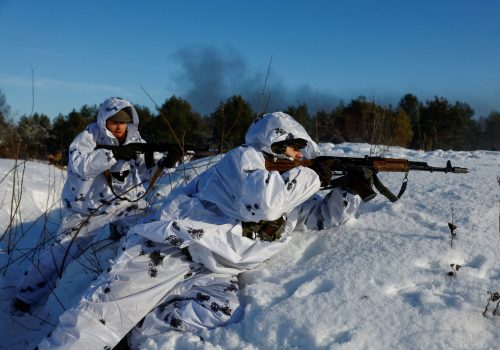
Ukrainian President Volodymyr Zelenskyy has announced the removal of Ukraine’s top general, Valery Zaluzhny, in the biggest shakeup of the country’s military leadership since the start of Russia’s full-scale invasion almost two years ago.
In a statement confirming the move, Zelenskyy said he had decided to “renew the leadership” of the Ukrainian military as he seeks to regain the initiative following last year’s failed counteroffensive. The Ukrainian President praised Zaluzhny’s contribution to the Ukrainian war effort but noted that the changing nature of the conflict and a “feeling of stagnation” meant sweeping changes were now necessary.
Stay updated
As the world watches the Russian invasion of Ukraine unfold, UkraineAlert delivers the best Atlantic Council expert insight and analysis on Ukraine twice a week directly to your inbox.
The decision to change Ukraine’s military leadership comes following months of speculation over deteriorating personal relations between Zelenskyy and Zaluzhny. Rumors of mounting tensions first began to circulate in 2022, with the Ukrainian President accused of viewing his top commander’s surging popularity among the Ukrainian public as a potential future threat to his own position.
During the early months of war, Zaluzhny emerged as a symbol of Ukraine’s fighting spirit as the country scored a string of remarkable victories against the invading Russians. He was soon being dubbed the “Iron General,” and was lionized in the Ukrainian and international media as a military mastermind.
The rift between Zelenskyy and Zaluzhny finally went public in late 2023, with the Ukrainian leader rebuking his military chief for stating that the war had reached a “stalemate” during a high-profile interview with Britain’s The Economist magazine. In a strongly worded response, Zelenskyy rejected Zaluzhny’s downbeat battlefield assessment, warning that it “aided the aggressor” and risked stirring up panic among Ukraine’s Western partners. This spat highlighted Zaluzhny’s growing tendency to go “off message” and challenge official Ukrainian positions in his interactions with the media.
Tensions have continued to rise in recent months, with the two men increasingly at odds over mobilization plans as Ukraine seeks to bolster the ranks of its depleted and exhausted military. In an opinion piece for CNN on the eve of his removal, Zaluzhny voiced his frustration with “the inability of state institutions in Ukraine to improve the manpower levels of our armed forces without the use of unpopular measures.”
Eurasia Center events

Zelenskyy has sought to downplay suggestions that today’s shakeup is the result of personal conflicts behind the scenes among the country’s civilian and military leadership. “This is not about surnames. And certainly not about politics,” he stated. Instead, the Ukrainian President spoke of the need for new management of the military and a more “technologically advanced” approach to the war.
Few would argue with Zelenskyy’s assertion that technological innovation should be among the top priorities for the outgunned but agile Ukrainian military. After all, Russia enjoys overwhelming advantages in a conventional war of attrition and is clearly aiming to wear Ukraine down while outlasting the West. However, when selecting his new Commander-in-Chief, the Ukrainian leader appears to have been guided primarily by the need for loyalty and stability.
Zaluzhny will be replaced as Ukraine’s top general by Oleksandr Syrsky, one of the country’s most experienced commanders who has led Ukraine’s ground forces since 2019. At 58 years old, Syrsky is significantly older than either Zelenskyy or Zaluzhny. He began his military career during the Soviet era, serving with the Red Army in Afghanistan.
Syrsky has held leadership positions within the Ukrainian military since the start of the Russian invasion in 2014 and has worked closely with Zaluzhny. He is credited with overseeing many of the most striking successes of the past two years, including the defense of Kyiv in the first month of the invasion and the stunning Kharkiv counteroffensive of September 2022.
Ukraine’s new Commander-in-Chief undoubtedly has an impressive resume as a military commander, but he has also faced significant criticism for his role in the Battle of Bakhmut, which resulted in heavy casualties on both sides. Opponents claim Syrsky is not popular within the ranks of the Ukrainian army, with some warning that his appointment could lead to a decline in morale among front line troops.
While Zelenskyy’s decision to dismiss Zaluzhny comes as no surprise, it is one of the Ukrainian leader’s biggest gambles of the entire war. With no major breakthroughs for more than a year, the need for a change in tactics was obvious. The breakdown in relations between the two men had also reached a point where it was creating dangerous divisions within the country’s leadership.
Nevertheless, the timing of Zaluzhny’s removal looks particularly unfortunate. Ukraine currently faces growing ammunition shortages amid alarming delays in Western military aid. This is already placing severe constraints on any offensive operations and has left Ukrainian commanders with little choice but to switch to active defense. If the military situation deteriorates further in the coming months, Zelenskyy will now find that he is held personally responsible.
Peter Dickinson is editor of the Atlantic Council’s UkraineAlert service.
Further reading
The views expressed in UkraineAlert are solely those of the authors and do not necessarily reflect the views of the Atlantic Council, its staff, or its supporters.

The Eurasia Center’s mission is to enhance transatlantic cooperation in promoting stability, democratic values and prosperity in Eurasia, from Eastern Europe and Turkey in the West to the Caucasus, Russia and Central Asia in the East.
Follow us on social media
and support our work
Image: Chief of the Ukrainian Armed Forces Valerii Zaluzhnyi visits a monument to Holodomor victims during a commemoration ceremony of the famine of 1932-33, in which millions died of hunger, in Kyiv, Ukraine November 25, 2023. The ceremony happens amid Russia’s attack on Ukraine. REUTERS/Viacheslav Ratynskyi
